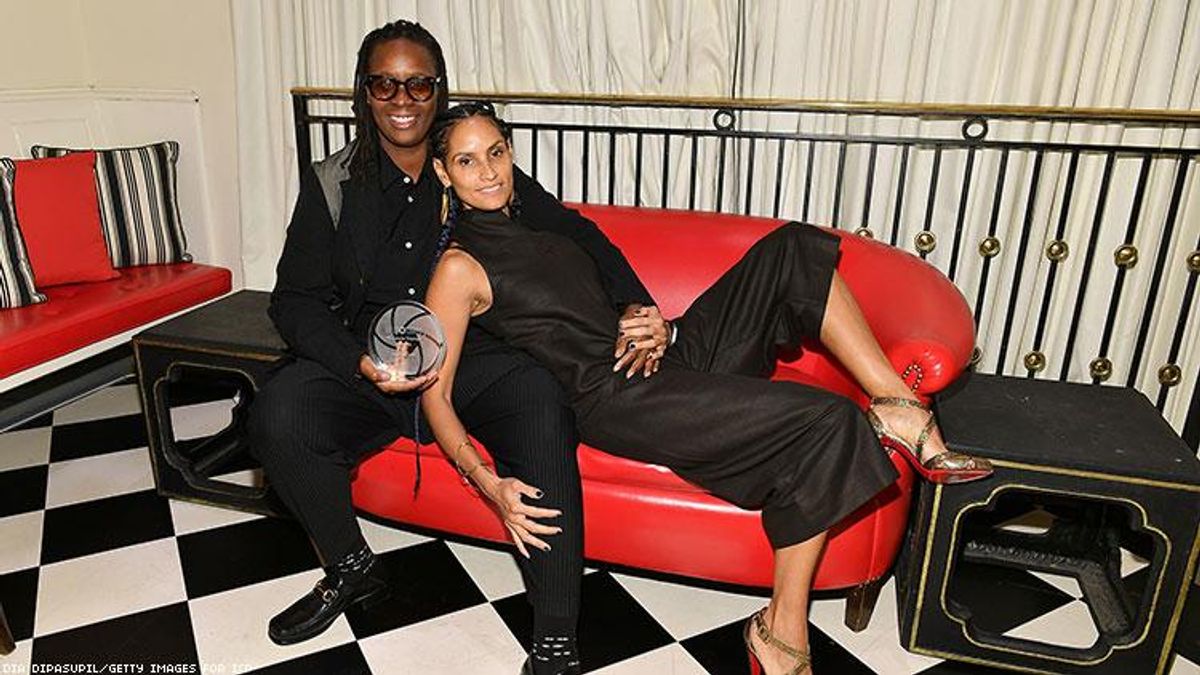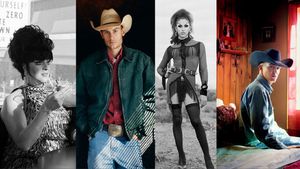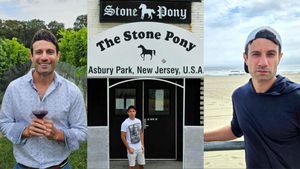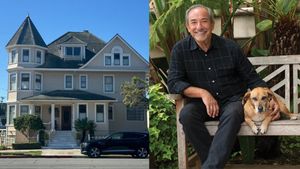In March 2018, art consultant Racquel Chevremont and her partner, multimedia artist Mickalene Thomas, jointly curated The Aesthetics of Matter exhibition at the Volta New York art fair. The groundbreaking night served as a launch of sorts for the pair's new effort, Deux Femmes Noires, which aims to increase visibility and opportunities for artists of color, specifically women and those who are queer. Impressively, half of the show's eight-person lineup was comprised of women artists, including Kennedy Yanko, Kameelah Janan Rasheed, and Christie Neptune.
"It is more difficult for a woman or a person of color to get a foot in the door in just about any field, so the art world is really no different," Chevremont says. "It was so great to see the artists in awe, as the people they've seen at openings but perhaps were afraid to speak to came up to them and engaged with them in a meaningful way."
That night, DFN's mission, which includes providing guidance and career opportunities, curating shows, advising institutions on artists they believe should receive attention, and securing exhibition funding, took center stage. As a result of the connections made at Volta, multiple artists featured in the exhibition have had their work added to museum collections, been added to other group exhibitions, or found gallery representation.
In a similar vein to DFN, design collaborator Bob Faust and his partner, artist Nick Cave, opened Facility, a multi-disciplinary two-story brick art space in Chicago's South Old Irving Park, late last year. "This space, in part, was about finding a way to reach out in our own community and use [Nick's] platform, his space, his mentorship even, and his association to help launch other younger, very valuable beings into the world," Faust says. Facility also functions as the working studio for the pair's own work: providing access, assistance, and validation for artists who are not cisgender, heterosexual white men is important.
"Primarily, [the art world] is a very top-down situation," speaker and art critic Alexis Clements says. "Tom Finkelpearl, who is the commissioner for cultural affairs in New York City, did a survey, and it showed what we all knew anecdotally, that the boards and the leadership of cultural institutions in this city are enormously biased in terms of demographics and cultural grounding. It's almost entirely cis white men who are by-and-large straight." And those men, who pose as gatekeepers for the art establishment, make decisions that affect not only which artists can establish viable and recognized careers, but also which pieces and interpretations are added to the canon.
In 2014, Thomas -- known for her depictions of Black women in elaborate configurations of rhinestones, acrylic, and enamel -- began shooting Je t'aime, a collaborative film series with Chevremont. In the film noir work, the duo film one another in black-and-white footage, first in Hotel Costes in Paris, and later in Connecticut. The purpose: to show how each sees the other, resulting in personal and intimate 20-minute moving portraits, capturing nude moments, typically only viewable to lovers. And though the piece is painstakingly beautiful and honest, it has been omitted from Thomas's oeuvre by some art institutions.
"We've had a few museums choose not to include [it]," Chevremont says. She explains that while the intimacy of the work may be palpable, in none of its frames does she and Thomas ever appear together. "These same institutions, though, have shown intimate pieces by heterosexual men and their sexual partners. Much of our country is still pretty conservative when it comes to sexuality, and the boards and trustees of these institutions tend to be populated by the older generation, which sometimes plays a part in what's shown." The Je t'aime series isn't alone; for queer artists, museums and galleries can impose a forced closeting, and disincentivize those artists exploring sexuality in their works.
Paul Cadmus's 1934 painting The Fleet's In! was infamously removed from an exhibition at the now-defunct Corcoran Gallery of Art for, among other things, its depiction of a sailor being seemingly propositioned (via a cigarette) by a civilian coded as a gay male. The Corcoran struck again in 1989 when the museum's director canceled an impending Robert Mapplethorpe exhibition because of the growing controversy surrounding his explicitly homoerotic images.
"Museums are terrified by the long shadow cast by that brouhaha, that, in many respects, heralded the culture wars of the early '90s," says Dr. Jonathan Katz, director of the doctoral program in visual studies at the University at Buffalo, of the Mapplethorpe cancellation, which spurred protests and a nationwide dialogue. "In response, the museum world enforces a closeting of queer artists." This means museums present blue-chip names like Ellsworth Kelly, Jasper Johns, and Robert Rauschenberg (among others) as ostensibly heterosexual, which can stunt true understanding surrounding the context of an artist's work. And this is done, in part, because of the largely white, heterosexual, cisgender, male gatekeepers.
"This isn't universally true, but most of those folks were brought up in a cultural context where they will say something is 'good taste' or 'good art,' but what they've learned is 'good' is obviously incredibly biased, based on the cultural-specific worlds in which they grew up," Clements explains. The result sees work by artists who are female, persons of color, and/or queer sidelined or ruled in some ways unacceptable as they are matched up against an unequal rubric.
This article appears in Out's May issue featuring artist Zanele Muholi and model Ruth Bell as cover stars. The issue isguest edited by Kimberly Drew. To read more, grab your own copy of the issue on Kindle, Nook, Zinio or (newly) Apple News+ today. Preview more of the issue here and click here to subscribe.
























































































